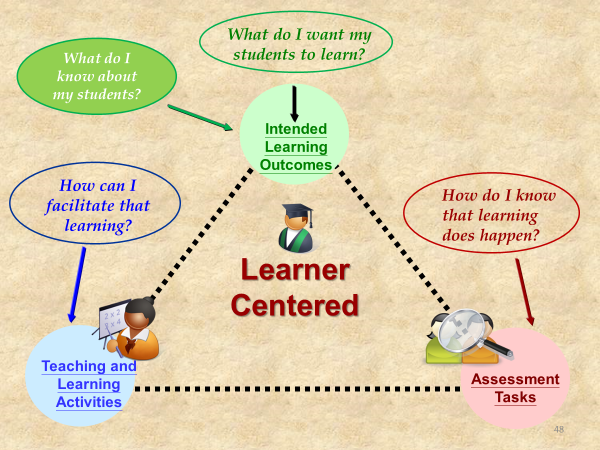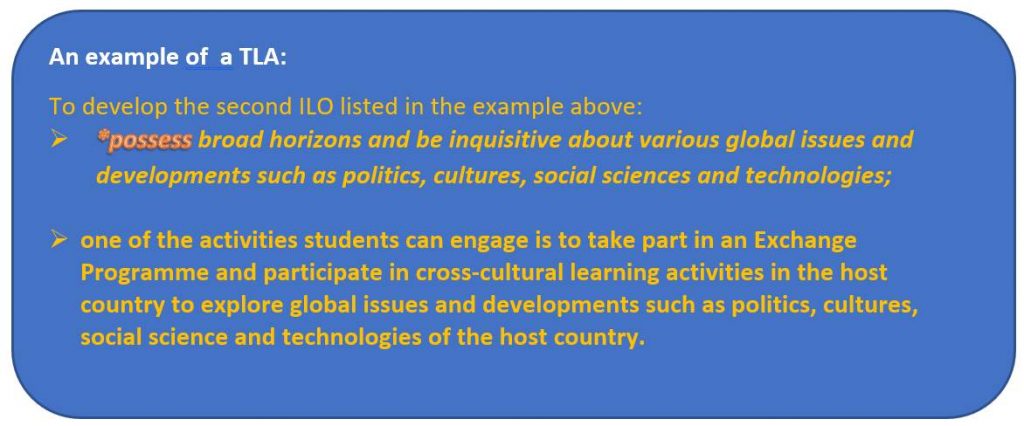i) How can the OBE approach be applied to the design of the curricula for teaching and learning?
The OBE approach can be applied to the design of the curricula for teaching and learning by incorporating three main elements for implementation. These three main elements are:
| Main elements of OBTL | Explanation |
|---|---|
| Intended learning outcomes (ILOs) | Knowledge / skills / attitude which are expected to be developed. |
| Teaching and learning activities (TLAs) | Learning activities which are designed to support the students’ development of the corresponding ILO(s). |
| Assessment tasks (ATs) | Assessment tasks / activities which are designed to measure how successful the students have developed the ILO(s) and evidence of their achievement of the ILO(s) can be provided. |
This framework is referred to as Outcomes-based Teaching and Learning (OBTL).
The delivery of a programme or a module with an OBTL framework in HSUHK can be represented by the following diagram:

In other words, when designing a programme / module / extra- or co-curricular activities, student learning is the main focus. This student–centred approach which concentrates on how best to facilitate student learning versus a teacher-centred approach which pays attention to how best a teacher can teach is another reason why OBTL is practiced in HSUHK.
ii) What are Intended Learning Outcomes?
► Intended Learning Outcomes (ILOs) are the expected achievements, namely, knowledge / skills / attitude expected to be developed after engagement in learning activities specifically designed for the purpose.
► In an ILO statement, the learning outcome is characterized by an *action verb which expresses an observable behavior of the student which can also be assessed.
The designed teaching and learning activities and assessment tasks must be able to support the students’ development of the intended learning outcomes of students and their assessment. This is referred to as ‘alignment’ of the TLAs and ATs to the ILOs so that the student can maximize the learning in the learning process.

► The action verbs ‘evaluate’, and ‘possess’ are distinct behavior which are expected to be developed in students. These behaviour can be observed through tasks assigned by teachers which can be assessed as explained below.
iii) How are Teaching and Learning Activities designed?
► Teaching and learning activities (TLAs) are in-class and / or out-of-class activities designed to facilitate students’ development of the specific ILO(s).

► The Exchange Programme (an example of a TLA) can enable students to have the opportunity to participate in cross-cultural activities (an example of a TLA) in the host country to interact with students from different ethnic / cultural backgrounds and explore the different issues as listed in the ILO.
iv) How can the developed ILO be assessed?
► To measure how successful the student has developed the ILO, an assessment task (AT) is designed to evaluate if the ILO has been achieved.

v) What is the relationship between the assessment rubric and assessment task?
► In HSUHK, when teachers introduce an AT, a set of guidelines are provided to students to help them to perform the task, e.g. how to prepare the report on the cross –cultural learning activities described in the example above.
► These guidelines are referred to as ‘assessment rubric’ which clearly informs students of the expectations and requirements of the specific AT including:
• the assessment criterion used,
• detail descriptions of different levels of performance of each criterion, and
• the different grades awarded to different levels of performance for each criterion.
An example of the assessment rubric for Participation and Discussion in a HSUHK module BUS4004 Business to Business Marketing is shown below:


► The assessment rubric also serves as a marking scheme for teachers to mark your completed assignment. In other words, teachers will grade each student’s submitted assignment based on the assessment rubric. This method is referred to as “criterion-referenced assessment”.
► To support students perform the assessment task with clear instructions, teachers usually present these assessment rubrics to students with full explanations during the first lession of the related module.
